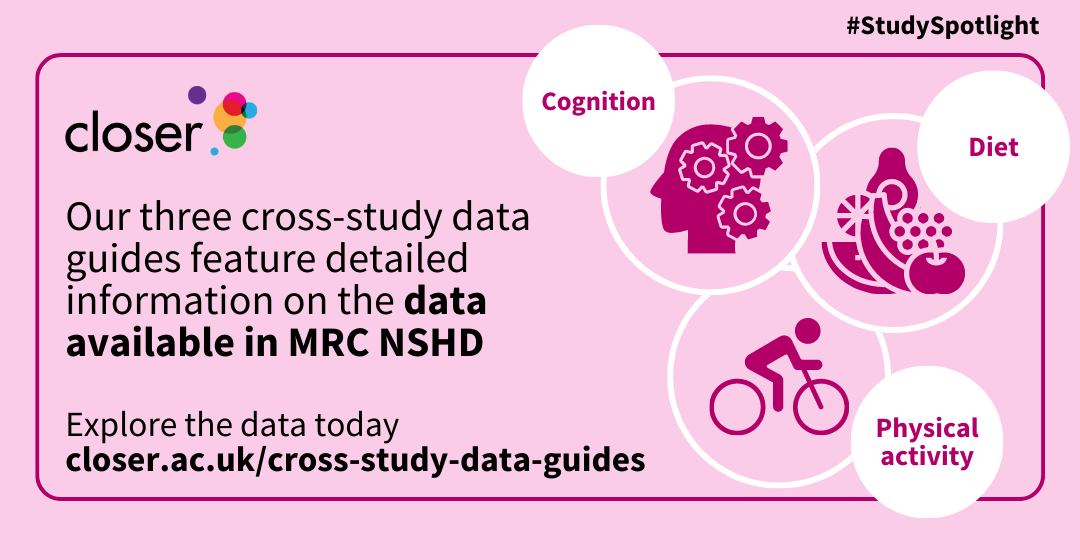 In this instalment of our Study Spotlight series, we shine a light on the longest-running of the British birth cohort studies – the MRC National Survey of Health and Development – as we continue to showcase our partner studies that follow the UK’s ageing population.
In this instalment of our Study Spotlight series, we shine a light on the longest-running of the British birth cohort studies – the MRC National Survey of Health and Development – as we continue to showcase our partner studies that follow the UK’s ageing population.
About the study
Funded by the Medical Research Council (MRC) since 1962, the National Survey of Health and Development (NSHD) – also known as the 1946 Birth Cohort – follows 5,362 people born in England, Scotland, and Wales in a single week in March 1946.
During the 1930s and 1940s there were worries about the falling birth rate in the UK and concerns that perhaps, in those years before the National Health Service (NHS), the cost of having children was so great that people were deterred from parenthood. A survey was designed to investigate these worries and provide information for use in the design of the NHS. This maternity study was so successful that two years later the first participant follow-up survey was conducted and the NSHD has been running ever since.
During childhood, the main aim of the NSHD was to investigate how the environment at home and school affected participants’ physical and mental development and educational attainment. As study participants reached adulthood, the main aim turned to investigate how childhood development and lifetime social circumstances and lifestyle affected adult health and function and how these change with age.
Now that participants have reached their late seventies, the NSHD has developed into a life course study of ageing and a vital source of evidence on the long-term biological and social processes of ageing.
Recent research using the study data has investigated:
- Lower respiratory tract infections in childhood and premature adult death from respiratory disease
- Age at menopause and cognition in later life
- Brain ageing and dementia
Discover the data
With data collection spanning seven decades and questionnaires completed by not just the participants but also their mothers, teachers, school nurses and doctors, you may feel somewhat overwhelmed when tasked with finding the right data for your research. That’s where CLOSER Discovery can help!
CLOSER Discovery is our innovative research tool that enables you to search, explore and assess NSHD data in an unprecedented level of detail. A filtered search, looking solely at NSHD metadata, pulls up detailed information about 6,121 questions and 10,216 variables from the study. Research topics covered include physical health, health care and behaviour, education, employment, income and more!
Response to the COVID-19 pandemic
The NSHD is one of five national longitudinal population studies that worked together during the early stages of the pandemic to conduct bespoke COVID-19 surveys to help understand the impact of the pandemic on their participants. The NSHD also joined the Longitudinal Health and Wellbeing National Core Study which brought together 12 longitudinal population studies to aid our understanding of the health, social and economic impacts of the pandemic and help inform policy.
Cross-study data from the NSHD on COVID-19 and four other longitudinal population studies found that COVID-19 infection was associated with poorer mental health in all age groups, with evidence of stronger associations for people aged 50 and older.
Interested in finding out more? You can use our COVID-19 Research Tracker to access all the briefing notes, reports, academic publications and articles that have cited NSHD COVID-19 data. Keep an eye on our updates, as we’re planning to add the NSHD metadata from these surveys to CLOSER Discovery later this year.
Opportunities for cross-study research
 You can use cross-study analysis to help understand more about group differences, the role of contextual factors and even how societal changes may impact on outcomes for individuals. The COVID-19 and mental health research mentioned above is a prime example of how the NSHD can be included in your own cross-study investigations. We’ve created a set of three cross-study data guides to help your cross-study comparisons. Use these to explore measures of cognition, diet and physical activity collected within and across multiple longitudinal population studies. Detailed information about the measures collected in the NSHD are included in all three guides.
You can use cross-study analysis to help understand more about group differences, the role of contextual factors and even how societal changes may impact on outcomes for individuals. The COVID-19 and mental health research mentioned above is a prime example of how the NSHD can be included in your own cross-study investigations. We’ve created a set of three cross-study data guides to help your cross-study comparisons. Use these to explore measures of cognition, diet and physical activity collected within and across multiple longitudinal population studies. Detailed information about the measures collected in the NSHD are included in all three guides.
NSHD data also features in three of our harmonised datasets, which aim to support researchers to conduct cross-study projects. These include harmonised measures of the following themes, collected across five longitudinal population studies:
Longitudinal research on the rise of the obesity pandemic, which used the harmonised dataset of body size and composition measures found that children born since 1990 are up to three times more likely to be overweight or obese by the age of 10 than older generations were in their childhood.
Scratching the surface
Of course, this spotlight only scratches the surface of how you can use CLOSER’s research resources to make the most of NSHD data in your own research. We’re looking forward to seeing what’s next for the 1946 birth cohort and continuing our work together in the CLOSER partnership.
You can keep up to date with all the latest news and developments on NSHD and the longitudinal research community direct to your inbox, via our monthly newsletter, Longitudinal News.
Further information
This blog is part of our ‘Study Spotlight’ series. This series showcases the CLOSER partner studies, demonstrating how to make the most of these valuable assets through CLOSER’s research resources. Every month, we turn the spotlight on a new theme, producing a series of blogs that delve into the backgrounds of studies that share similar characteristics, such as their study sample, design, or topics of research interest.
‘Study Spotlight’ helps you gain a deeper understanding of the studies in our partnership and how you can better utilise these on your research journey.
Keep an eye out for next month’s instalments which will shine a light on the 1958, 1970 and 2000-01 British birth cohorts.
Previous Study Spotlight blogs:
- ALSPAC and the millennial generation (April 2023)
- Next Steps and the millennial generation (April 2023)
- ELSA and the ageing population (May 2023)
- HCS and the ageing population (May 2023)
On Twitter? Follow #StudySpotlight to keep up to date with the series throughout the year.
Related links:
- Follow @MRCLHA on Twitter
- NSHD CLOSER Study profile
- NSHD website
- Image sourced from the Centre for Ageing Better
Suggested citation:
Blows, J. (2023). ‘Study Spotlight: MRC NSHD and the ageing population’. CLOSER. 31 May 2023. Available at: https://closer.ac.uk/news-opinion/blog/study-spotlight-nshd/

